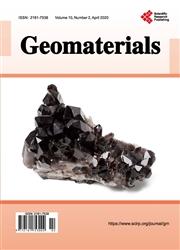Heterogeneous Photocatalytic Degradation of Dyes in Water/Alcohol Solution Used by the Brazilian Agate Industry
引用次数: 5
Abstract
The agate dyeing industry has been commonly seen as a high-pollution industry. Dyeing wastewater treatment is considered one of the most important categories for water-pollution control, because of its intense colour and the high concentration of organic contaminants. Most dyes used in the process present minimal biodegradability due to aromatic organic compounds in their structure. Using a photocatalytic reactor, experiments were carried out to study the decolorization of a water solution containing 8% ethylic alcohol and 200 mg L−1 of the dye Rhodamine B (RhB), the most difficult colorant to degrade among the used by the agate industry. The best conditions were further applied to treat the same agate water/ethyl alcohol solution containing a mixture of 200 mg L−1 of Rhodamine B (RhB), Crystal Violet (CV), Brilliant Green (BG), and Blood Red (BR). All the experiments were performed in a 2 L reactor equipped with ultraviolet (UV) lamps, at a wavelength of 365 nm, with powdered TiO2 or ZnO as the catalyst. The results indicated that the optimal decolorization conditions were attained with 2.5 g L−1 of the catalyst at pH 10 and an irradiation time of 80 min. The process resulted in complete degradation of CV, BG and 80% - 90% degradation of RhB and BR. The catalyst ZnO presented a performance somewhat better than TiO2. It is possible to conclude that the process of heterogeneous photocatalysis is effective for decolorization of water streams from the agate industry.巴西玛瑙工业用水/醇溶液中染料的非均相光催化降解
玛瑙染色行业一直被普遍认为是高污染行业。印染废水处理因其颜色浓烈、有机污染物浓度高而被认为是水污染控制的重要领域之一。由于其结构中含有芳香族有机化合物,在该过程中使用的大多数染料具有极小的生物降解性。利用光催化反应器,研究了玛瑙工业中最难降解的染料罗丹明B (Rhodamine B, RhB)溶液中含有8%乙醇和200 mg L−1的水溶液的脱色效果。将最佳条件进一步应用于含有200 mg L−1罗丹明B (RhB)、结晶紫(CV)、亮绿(BG)和血红(BR)的混合马瑙水/乙醇溶液。所有实验均在2l反应器中进行,并配有紫外灯,波长为365 nm,以TiO2或ZnO粉末为催化剂。结果表明,最佳脱色条件为:催化剂用量为2.5 g L−1,pH为10,辐照时间为80 min,可完全降解CV、BG, RhB和BR可降解80% ~ 90%。催化剂ZnO的性能略优于TiO2。可以得出结论,多相光催化工艺对玛瑙工业废水的脱色是有效的。
本文章由计算机程序翻译,如有差异,请以英文原文为准。
求助全文
约1分钟内获得全文
求助全文

 求助内容:
求助内容: 应助结果提醒方式:
应助结果提醒方式:


